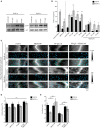Keratins Regulate p38MAPK-Dependent Desmoglein Binding Properties in Pemphigus
- PMID: 29616033
- PMCID: PMC5868517
- DOI: 10.3389/fimmu.2018.00528
Keratins Regulate p38MAPK-Dependent Desmoglein Binding Properties in Pemphigus
Abstract
Keratins are crucial for the anchorage of desmosomes. Severe alterations of keratin organization and detachment of filaments from the desmosomal plaque occur in the autoimmune dermatoses pemphigus vulgaris and pemphigus foliaceus (PF), which are mainly caused by autoantibodies against desmoglein (Dsg) 1 and 3. Keratin alterations are a structural hallmark in pemphigus pathogenesis and correlate with loss of intercellular adhesion. However, the significance for autoantibody-induced loss of intercellular adhesion is largely unknown. In wild-type (wt) murine keratinocytes, pemphigus autoantibodies induced keratin filament retraction. Under the same conditions, we used murine keratinocytes lacking all keratin filaments (KtyII k.o.) as a model system to dissect the role of keratins in pemphigus. KtyII k.o. cells show compromised intercellular adhesion without antibody (Ab) treatment, which was not impaired further by pathogenic pemphigus autoantibodies. Nevertheless, direct activation of p38MAPK via anisomycin further decreased intercellular adhesion indicating that cell cohesion was not completely abrogated in the absence of keratins. Direct inhibition of Dsg3, but not of Dsg1, interaction via pathogenic autoantibodies as revealed by atomic force microscopy was detectable in both cell lines demonstrating that keratins are not required for this phenomenon. However, PF-IgG shifted Dsg1-binding events from cell borders toward the free cell surface in wt cells. This led to a distribution pattern of Dsg1-binding events similar to KtyII k.o. cells under resting conditions. In keratin-deficient keratinocytes, PF-IgG impaired Dsg1-binding strength, which was not different from wt cells under resting conditions. In addition, pathogenic autoantibodies were capable of activating p38MAPK in both KtyII wt and k.o. cells, the latter of which already displayed robust p38MAPK activation under resting conditions. Since inhibition of p38MAPK blocked autoantibody-induced loss of intercellular adhesion in wt cells and restored baseline cell cohesion in keratin-deficient cells, we conclude that p38MAPK signaling is (i) critical for regulation of cell adhesion, (ii) regulated by keratins, and (iii) targets both keratin-dependent and -independent mechanisms.
Keywords: atomic force microscopy; desmoglein; desmosome; keratin; p38MAPK.
Figures







Similar articles
-
Non-pathogenic pemphigus foliaceus (PF) IgG acts synergistically with a directly pathogenic PF IgG to increase blistering by p38MAPK-dependent desmoglein 1 clustering.J Dermatol Sci. 2017 Mar;85(3):197-207. doi: 10.1016/j.jdermsci.2016.12.010. Epub 2016 Dec 12. J Dermatol Sci. 2017. PMID: 28024684 Free PMC article.
-
Different signaling patterns contribute to loss of keratinocyte cohesion dependent on autoantibody profile in pemphigus.Sci Rep. 2017 Jun 15;7(1):3579. doi: 10.1038/s41598-017-03697-7. Sci Rep. 2017. PMID: 28620161 Free PMC article.
-
Keratin Retraction and Desmoglein3 Internalization Independently Contribute to Autoantibody-Induced Cell Dissociation in Pemphigus Vulgaris.Front Immunol. 2018 Apr 25;9:858. doi: 10.3389/fimmu.2018.00858. eCollection 2018. Front Immunol. 2018. PMID: 29922278 Free PMC article.
-
New insights into desmosome regulation and pemphigus blistering as a desmosome-remodeling disease.Kaohsiung J Med Sci. 2013 Jan;29(1):1-13. doi: 10.1016/j.kjms.2012.08.001. Epub 2012 Oct 12. Kaohsiung J Med Sci. 2013. PMID: 23257250 Free PMC article. Review.
-
Desmosomal cadherins and signaling: lessons from autoimmune disease.Cell Commun Adhes. 2014 Feb;21(1):77-84. doi: 10.3109/15419061.2013.877000. Cell Commun Adhes. 2014. PMID: 24460203 Review.
Cited by
-
Desmoglein 2 can undergo Ca2+-dependent interactions with both desmosomal and classical cadherins including E-cadherin and N-cadherin.Biophys J. 2022 Apr 5;121(7):1322-1335. doi: 10.1016/j.bpj.2022.02.023. Epub 2022 Feb 17. Biophys J. 2022. PMID: 35183520 Free PMC article.
-
What protein kinases are crucial for acantholysis and blister formation in pemphigus vulgaris? A systematic review.J Cell Physiol. 2022 Jul;237(7):2825-2837. doi: 10.1002/jcp.30784. Epub 2022 May 26. J Cell Physiol. 2022. PMID: 35616233 Free PMC article.
-
Cardiomyocyte adhesion and hyperadhesion differentially require ERK1/2 and plakoglobin.JCI Insight. 2020 Sep 17;5(18):e140066. doi: 10.1172/jci.insight.140066. JCI Insight. 2020. PMID: 32841221 Free PMC article.
-
Identification of Six microRNAs as Potential Biomarkers for Pemphigus Vulgaris: From Diagnosis to Pathogenesis.Diagnostics (Basel). 2022 Dec 6;12(12):3058. doi: 10.3390/diagnostics12123058. Diagnostics (Basel). 2022. PMID: 36553065 Free PMC article.
-
Pemphigus Foliaceus Autoantibodies Induce Redistribution Primarily of Extradesmosomal Desmoglein 1 in the Cell Membrane.Front Immunol. 2022 May 12;13:882116. doi: 10.3389/fimmu.2022.882116. eCollection 2022. Front Immunol. 2022. PMID: 35634274 Free PMC article.
References
Publication types
MeSH terms
Substances
LinkOut - more resources
Full Text Sources
Other Literature Sources
Medical
Miscellaneous

